DMM UNI-T UT195DS
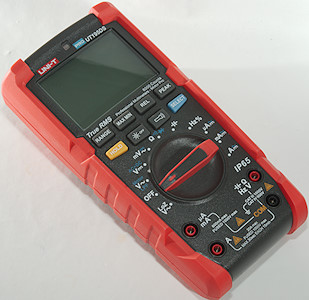
This is a industrial grade DMM designed for electricians. This is the the most advanced of the meters in the 195 series.
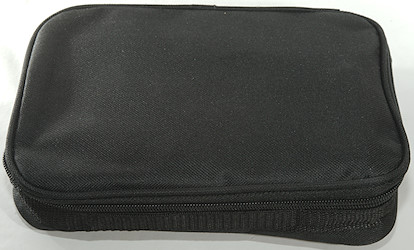
I got it without the box, but in the pouch.
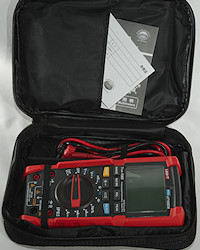
With all parts inside.
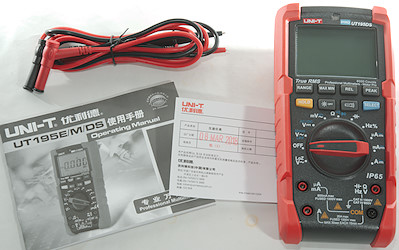
That was the meter, the probes and a Chinese manual (I could download an English version).


Probes are branded UNI-T and rated for 20A, they have very low resistance this means the 20A rating is probably good enough.

With a tip cover they are CAT IV 600V or CAT III 1000V, without CAT II 1000V (This is fairly standard for probes).
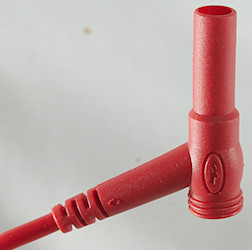
The plugs are fully shrouded, but the shroud is a bit short
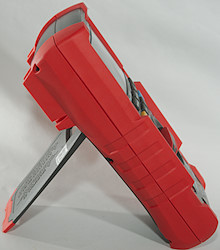

The meter is a bit heavy and the range switch easy to turn, this means it can easily be used with one hand, either lying flat or standing.
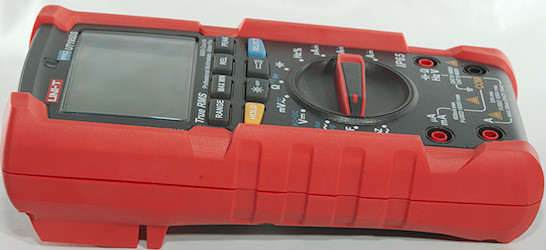
All the red plastic is slightly rubberized in feel including the range switch.
The red plastic works as bumpers from any direction.
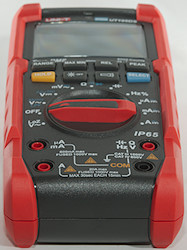
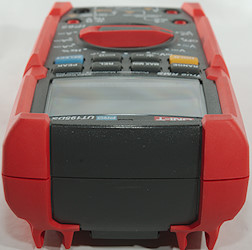
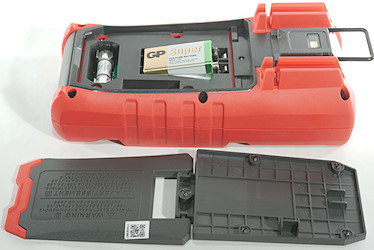
The battery/fuse compartment is sealed and due to that the lid uses 5 screws, that usual stays in the lid (i.e. no lost screws).
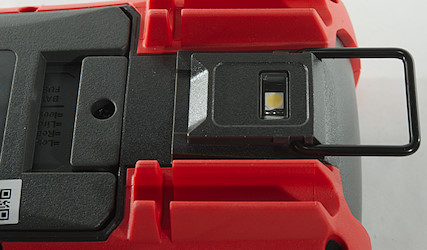
The flashlight led and a hanger.
Display
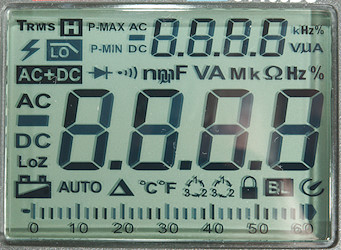
All the segments are shown during power on. A few symbols are not used by this meter.
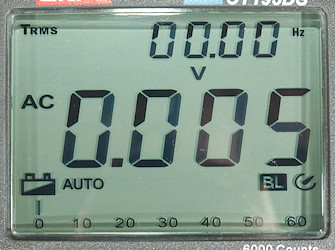
Typical display during usage, it will show the number and selected measurement and sometimes the secondary display.
Secondary display functions:
- In AC+DC secondary display will change between AC and DC voltage automatic.
- In AC it will show frequency.
- When min/max is active it will show min/max, main display shows actual value.
- When Peak is active it will show peak min/max, main display shows actual value.
- In frequency it will show duty cycle.
Functions
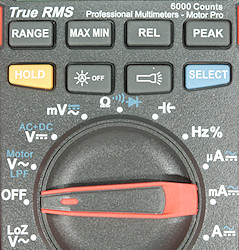
Buttons:
- Range: Select manual range and change range, hold down to reactivate automatic ranging
- Max/min: Capture maximum and minimum values, secondary display will show value. Hold down to disable.
- Rel: Shows values relative to current value, will also select manual range. Press again to disable.
- Peak: Capture peak values, this can only be used in AC modes, secondary display will show value. Hold down to disable.
- Hold (Yellow): Will freeze the display reading, until pressed again.
 : Turn automatic backlight off until next power cycle.
: Turn automatic backlight off until next power cycle.
 : Turn flashlight on or off.
: Turn flashlight on or off.
- Select (Blue): Select DC/AC in voltage and current modes, continuity and diode in ohm mode.
Rotary switch:
- LoZ: Low input impedance (300kOhm), range is always 600VAC.
- Off: Meter is turned off
- VAC: AC voltage and peak detection, frequency is on secondary display when measuring AC.
- VDC: DC voltage and AC+DC voltage
- mV: AC or DC millivolt
 : Ohm, continuity and diode
: Ohm, continuity and diode
 : Capacitance.
: Capacitance.
- Hz: Logical frequency input and duty cycle.
- uA: Microampere DC or AC, frequency is on secondary display when measuring AC.
- mA: Milliampere DC or AC, frequency is on secondary display when measuring AC.
- A: Ampere DC or AC, frequency is on secondary display when measuring AC.
Input
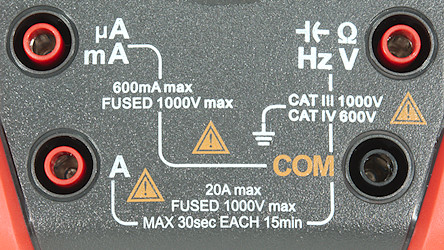
- uAmA: Micro and milliampere input.
- 20A: 20A current input.
- COM: The common terminal for all ranges.
- xxx: All other ranges.
Measurements
- Volt and frequency
- Millivolt range starts in AC
- 1V AC readings is 5% down at 20kHz (Both AC and AC+DC), rms will not work at that frequency
- 1V AC readings in LPF mode is 5% down at 600Hz, rms will not work at that frequency
- Frequency input do not require a zero crossing.
- At 1Vrms frequency input range is from 1.1Hz to 22MHz
- At 2Vrms frequency input range is stretched to 40MHz
- Duty cycle works from 1% to 90% at 100kHz with 2Vpp, precision is within 2.0.
- Duty cycle works from 1% to 99% at 100kHz with 4Vpp, precision is within 0.3.
- Default range for LPF mode is 1000VAC, but it can be changed with the RANGE switch (Mode do not support auto ranging).
- Max/min needs about 150ms to capture a voltage, auto range is disabled when using this function.
- Peak only work in AC and needs about 0.5ms to capture a voltage, auto range is disabled when using this function.
- Input impedance is 10-10.1Mohm on DC and AC
- mVDC is high impedance up to about 3V where it drops to about 100kOhm, above 12V it will drop to 3kOhm
- mVAC is the same, but capped by a 10MOhm resistor.
- LowZ is constant 300kOhm input impedance and is locked in 600VAC range.
- Input protection is 1000VDC/750VAC
- Current
- 20A range has audible alarm above 20A
- 20A range is fused with a 11A/1000V 10x38mm fuse
- mAuA range is fused with a 0.6A/1000V 6x32mm fuse
- Current ranges starts in DC
- Ohm, continuity, diode and capacitance
- Ohm needs about 1s to measure 100ohm
- Ohm voltage is -1.1V open and -0.24mA shorted.
- Continuity is very fast (About 3ms).
- Continuity beeps when resistance is below 30ohm.
- Continuity is -3.3V open and -0.93mA shorted
- Diode range uses 3.1V, max. display is 2.800V at 0.11mA, max. current is 1.1mA shorted
- 10uF takes about 1 seconds to measure.
- 11000uF takes about 10 seconds to measure.
- Overload protection is 1000V
- Miscellaneous
- Current consumption of meter is 5mA to 8.5mA depending on range (21mA with flashlight, 12mA with background light, max. 26mA).
- Meter turns off at 5V, battery symbol show at 7.2V.
- Readings will be correct until the meter turns off
- Backlight fades with dropping voltage and is mostly gone at 5.5V
- Flashlight fades slightly with dropping voltage, but is still bright when the meter turns off at 5V
- Viewing angle is good
- Display updates around 5 times/sec
- Bargraph is about 20 updates/sec
- Backlight will automatic turn on when in dark surroundings
- Flashlight will not turn off automatic, but turns off with the auto power off.
- Will automatic turn power off in about 15 minutes.
- Standard probes can nearly be fully seated in the meter.
- The meter need one or two display update to before it display the final value.
- Weight is 511g without accessories, but with battery.
- Size is 195 x 96 x 61mm
- Probes
- Probe resistance 14mOhm for one, that is very low.
- Probe wire are 88cm long and feels a bit stiff, probably due to the thickness.

A look at the capacitance measuring waveform with a 1uF capacitor.

Frequency input is 3Mohm to 10Mohm up to 12V where it drops to 3kOhm

mVDC is high impedance up to about 3V.

Tear down
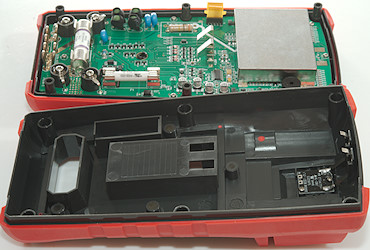
I had to remove 6 screws to open the meter. This meter uses metal inserts for the screws and they stay in the bottom (very nice).
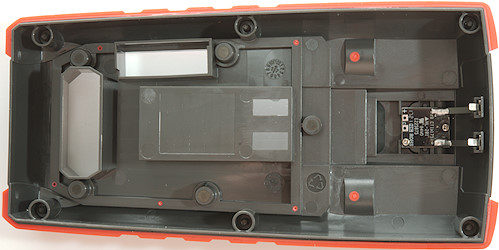
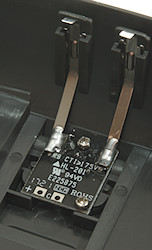
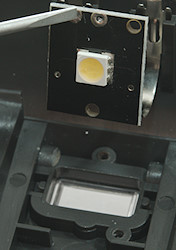
The flashlight, it uses two metal strips for contact to the circuit board.
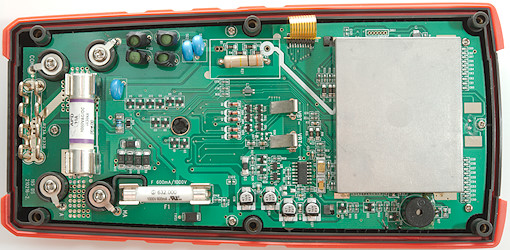
The main DMM chips are hidden under a metal can.
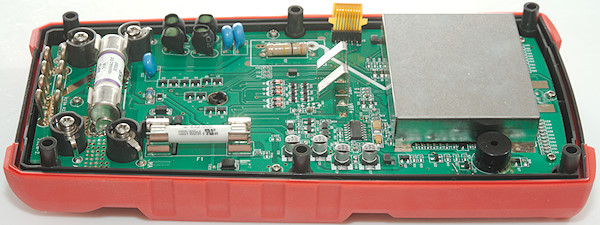
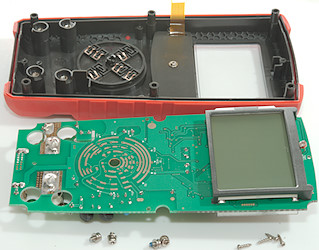
Four small screws and for larger screws at the input terminals, then I could remove the circuit board.
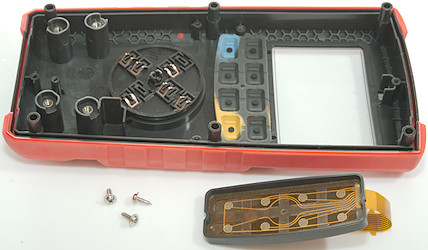
To see the buttons I needed to remove 3 more screws.
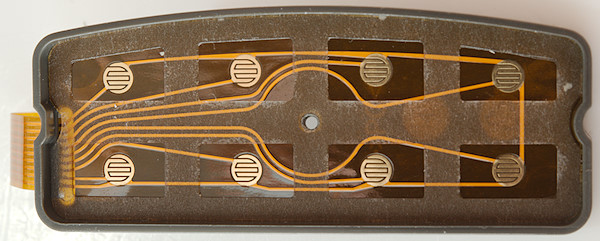
A flex circuit board is used for the buttons.
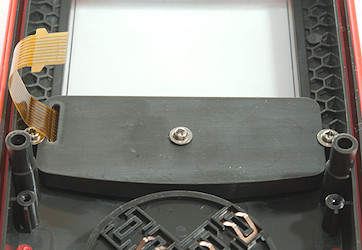
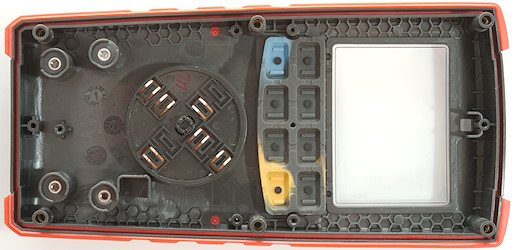
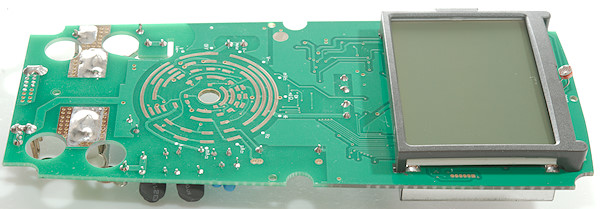
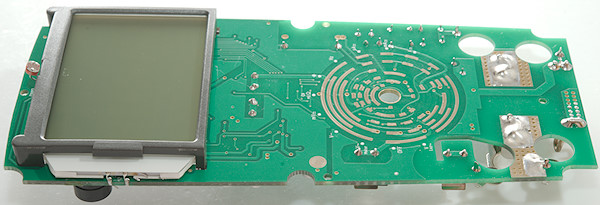
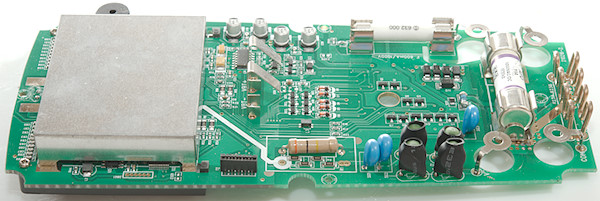
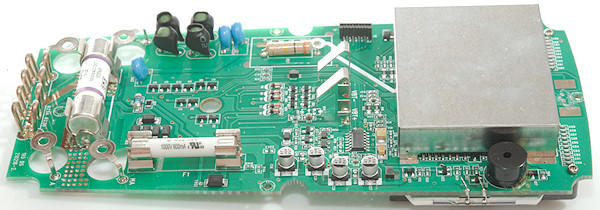
I am not that happy about the can, I need to remove the display and backlight, before I can remove it.
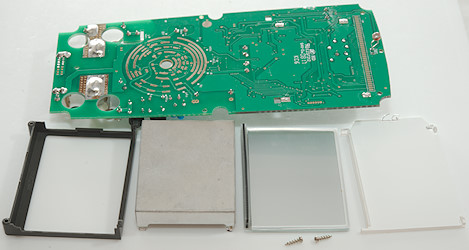
Two screws to remove the display, solder two wires to remove the backlight and four more soldering to get the can away.
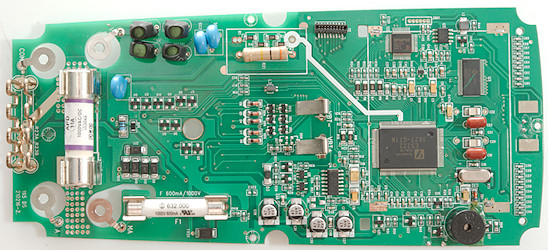
The 20A shunt (R23A & R23B) is really large in this meter, that probably means it can handle 10A for a very long time without getting too warm. The smaller current ranges are handle by two smaller resistors (R24: 1ohm & R25: 99ohm), with a diode bridge (D9..D13) and transient diode (TVS1) for protection. The voltage input has two paths, both protected with dual PTC's (PTC1, PTC2, PTC1A1, PTC2A1) and MOV's (SG1, SG2, SG3). The voltage path is 4 resistors (R1..R4: 4x2.5Mohm) with the optional LowZ resistor (R21: 300kohm).
There is also a lot of transistor pairs for protection mv (Q3 & Q4), ohm & capacitance (Q7 & Q8 and Q5 & Q6), frequency (Q1 & Q2). There is also a pair switched into the voltage input when in the uA range (Q9 & Q10), I wonder why.
All the diodes near the battery terminals (DD1..DD6 & D4..D8) I supposed are used for coding the range switch correctly for the multimeter IC.
The two chips (U7 & U8: marked PAO) are probably voltage regulators. The larger chip (U4: ES5) is a RMS converter. Below the can we have the multimeter chip (ES222), a microprocessor (U2: EFM32ZG222F32, 32kB flash, 4kB ram), a EEPROM (U5: 24256E 32Kx8) and a LCD driver (U3: HY2613B 4x36).

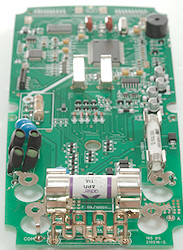
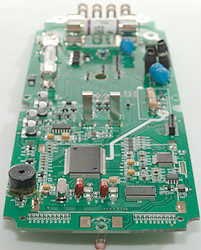

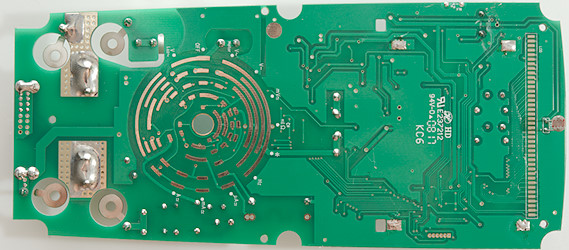
The only part on this side is the LDR for automatic backlight and then there is the pads for the range switch and LCD display.
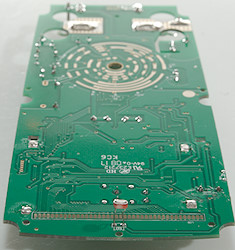
Conclusion
This meter has a lot of protection, i.e. the CAT rating is probably correct.
This meter has a good selection of ranges and functions, including peak, LowZ and flashlight. With the fairly high AC bandwidth the LPF function can also be useful. The automatic backlight looks like a useful feature. I am missing temperature and average.
This meter looks to be a rather robust meter
Notes
UNI-T do often make rebranded meters, i.e. it may exist with other names on it.
How do I review a DMM
More DMM reviews
 : Turn automatic backlight off until next power cycle.
: Turn automatic backlight off until next power cycle.
 : Turn flashlight on or off.
: Turn flashlight on or off.


















 : Turn automatic backlight off until next power cycle.
: Turn automatic backlight off until next power cycle.
 : Turn flashlight on or off.
: Turn flashlight on or off.
 : Ohm, continuity and diode
: Ohm, continuity and diode
 : Capacitance.
: Capacitance.



























